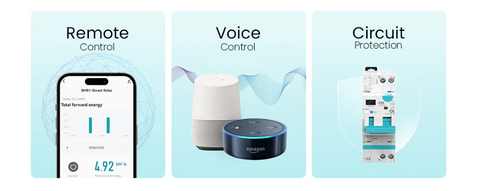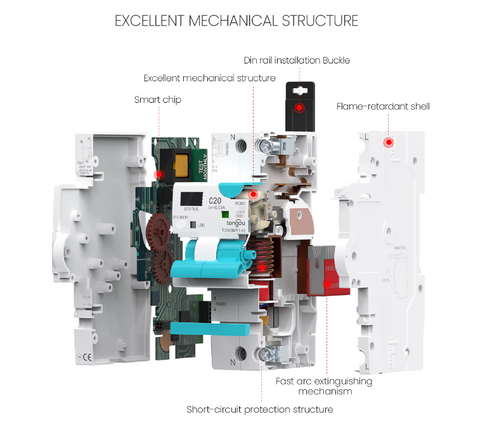What are the Difference between Regular RCBO and Smart RCBO?

Circuit protection devices keep electrical systems safe by preventing shocks, fires, and damage to equipment. These devices are designed to detect and interrupt abnormal electrical currents, protecting both people and property.
What is a RCBO? (Residual Current Circuit Breaker with Overcurrent Protection)
An RCBO is a circuit protection device that combines the functions of an RCD and an MCB. It offers protection against both earth leakage faults and overcurrents in a single unit.
Overview of regular RCBO and smart RCBO
There are two main types of RCBOs: regular RCBOs and smart RCBOs. Regular RCBOs provide basic circuit protection functions, while smart breaker RCBOs incorporate advanced features enabled by connectivity and automation.
What is a Regular RCBO?
A. Definition and function of regular RCBO
Regular RCBOs are standalone devices that protect against earth leakage faults and overcurrents. They automatically stop the circuit if there is too much current, protecting electrical equipment and reducing the chance of accidents.
B. Components and features
Regular RCBOs have three main parts: an RCD module, an MCB module, and an electromechanical trip mechanism. They typically have manual reset buttons and indicator lights to provide visual feedback on their status.
C. Operating principles
Regular RCBOs operate based on the principle of detecting imbalances in electrical currents. The RCBO senses when something goes wrong, such as a current leak or excessive current. It then stops the circuit from functioning.
D. Advantages and limitations of regular RCBO
Regular RCBOs offer reliable and effective circuit protection for various applications. They are relatively simple in design, easy to install, and cost-effective. However, regular RCBOs lack advanced features such as remote control, monitoring, and automation capabilities.
E. Common applications
Regular RCBOs are often used in homes, businesses, and factories to safeguard circuits that provide electricity to outlets, lights, and appliances.
What is a Smart RCBO?
A. Definition and function of smart RCBO
Smart RCBOs are advanced versions of regular RCBOs that incorporate additional features enabled by connectivity and automation. They provide enhanced functionality and greater control over circuit protection.
B. Components and features
Smart RCBOs include the components found in regular RCBOs, along with additional electronic components for connectivity and data processing. They are equipped with communication interfaces, sensors, microprocessors, and memory to enable smart features.
C. Operating principles
Smart RCBOs operate using the same fundamental principles as regular RCBOs, detecting abnormal currents and tripping the circuit when necessary. However, they also utilize additional features to enable advanced monitoring, control, and automation capabilities.
D. Advantages and benefits of smart RCBO
Smart RCBOs offer several advantages over regular RCBOs. They provide live monitoring of electrical data. They also offer remote control features. Additionally, they have advanced diagnostic and reporting capabilities. They can be integrated with smart home systems. Lastly, they provide smarter detection and response to electrical faults.
E. Common applications
Smart RCBOs are suitable for a wide range of applications, including residential, commercial, and industrial settings. They are particularly useful in environments where remote monitoring, automation, and advanced circuit protection features are desired.
Key Differences between Regular RCBO and Smart RCBO

A. Connectivity and integration capabilities
Smart RCBOs are designed to connect to the local network and communicate with other smart devices and systems. They can integrate with home automation systems, allowing users to monitor and control their electrical circuits remotely. Regular RCBOs, on the other hand, operate independently and do not offer connectivity or integration capabilities.
B. Monitoring and diagnostic features
Smart RCBOs provide real-time monitoring of electrical parameters such as current, voltage, and power consumption. They can detect and report abnormal conditions or faults, providing valuable insights for troubleshooting and maintenance. Regular RCBOs lack these monitoring and diagnostic capabilities.
C. Remote control and automation
Smart RCBOs can be remotely controlled and managed through mobile apps or smart home systems. Users can monitor the status of circuits, receive notifications of faults, and even remotely trip or reset the RCBOs if needed. Regular RCBOs require manual intervention for control and cannot be remotely accessed or automated.
D. Enhanced safety features
Smart RCBOs have additional safety features, such as load shedding. Load shedding disconnects non-essential loads when there is an overload or fault. This helps prevent further damage.
They can also provide advanced protection algorithms to detect specific types of faults more accurately. Regular RCBOs do not have these enhanced safety features.
E. Energy management and efficiency
Smart RCBOs can provide insights into energy consumption patterns and help optimize energy usage. They can track power consumption at the circuit level and provide data for energy management purposes. Regular RCBOs do not have energy management features.
F. Cost considerations
Smart RCBOs typically have a higher initial cost compared to regular RCBOs due to their advanced features and connectivity capabilities. However, the benefits and functionality they offer may outweigh the additional cost in certain applications where remote monitoring, control, and automation are valuable.
Choosing the Right RCBO for Your Needs

A. Assessing specific requirements
Consider the specific requirements of your electrical system and the level of functionality you need. Determine if remote monitoring, control, and automation features are necessary or if basic circuit protection provided by a regular RCBO will suffice.
B. Understanding the budget and investment considerations
Evaluate your budget and consider the long-term benefits and cost savings associated with smart RCBOs. Determine if the additional features and functionalities provided by smart RCBOs align with your budget and justify the investment.
C. Evaluating the benefits and drawbacks
Weigh the advantages and disadvantages of both regular RCBOs and smart RCBOs based on your specific needs. Consider the value of advanced features such as remote control, monitoring, and energy management against the higher cost of smart RCBOs.
D. Consulting with professionals and experts
Consult with electrical professionals or experts who can provide guidance based on their knowledge and experience. They can help assess your requirements, recommend the appropriate type of RCBO, and ensure compliance with relevant safety standards.
Conclusion
Regular RCBOs provide basic circuit protection. Smart RCBOs offer advanced features such as connectivity, remote control, monitoring, automation, enhanced safety, and energy management.
When selecting an RCBO, consider your specific needs, budget, desired functionality, and the long-term benefits associated with smart circuit breaker RCBOs.
The advancement of circuit protection technology, exemplified by smart breaker RCBOs, indicates a growing trend toward interconnected and intelligent electrical systems. As technology continues to evolve, we can expect further innovations in circuit protection devices, providing improved safety, efficiency, and convenience.
Contact:
AT-ELE
sale@at-ele.com
www.at-ele.com



